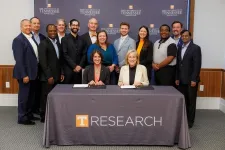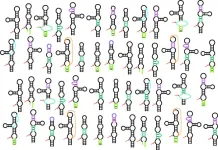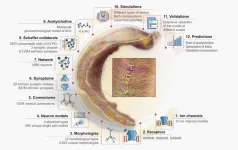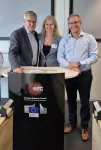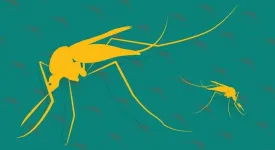(Press-News.org) The Biden administration’s recently announced plan to replace all lead pipes in the U.S. is a reminder that the toxic metal remains a threat, even in a country that has largely banned its use. The smallest levels of lead exposure can cause a range of health damages over time, especially to children’s brain development. Stanford researchers Stephen Luby and Jenna Forsyth have spent years examining the widespread presence of lead in low-income countries, including in some commonly consumed products. They led a perspective published Nov. 5 in The Lancet Public Health that tallies lead’s global health and economic costs, and a study in the November issue of Science of the Total Environment that highlights the urgent challenge of lead contamination in South Asian turmeric.
“Lead is a remarkably harmful toxin,” said Luby. “Even within the context of limited resources, we have to find ways to focus on reducing exposure to it.”
Below, Luby, the Lucy Becker Professor of Medicine in the Stanford School of Medicine, and Forsyth, a research scientist with the School of Medicine, discuss the prevalence of lead-tainted products, and share insights on how food safety policies, education, and lead-free alternatives could reduce the risks.
You call for a complete phase-out of lead by 2035. What do you see as the key hurdles to achieving this goal, especially in countries with limited regulatory enforcement?
Luby: The key hurdles include overcoming the pushback from industries that, like tobacco companies, have a financial incentive in continuing to generate a product that kills millions of people every year. This requires a clear-eyed view of the enormous human and environmental health costs of having lead in the economy.
When we consider the great success of removing chlorofluorocarbons from the atmosphere, the technological innovations in aerosol propellants and in refrigerants occurred in high-income countries within companies that understood that regulation was on the horizon. By the time the Montréal protocol came into force, low-income countries could purchase new-generation propellants in refrigerants that were affordable and did not exert such damage to the Earth’s protective ozone layer.
Lead contamination disproportionately affects marginalized communities. What policy interventions or public health measures could ensure that these vulnerable populations are protected?
Luby: Globally, industrial pollution is disproportionately discharged near communities with limited economic and political influence. Efforts to reduce industrial discharges are important, but because lead is so toxic to the environment and human life, the primary public health measure should be to remove it from the economy. This way, the whole web of life, including humans, would benefit.
Forsyth: And since lead does not degrade or go away on its own, remediation of current contaminated sites is a companion endeavor to reduce exposure among the most vulnerable.
Lead chromate in turmeric is a form of food fraud that can have devastating long-term effects. What immediate steps can governments and international organizations take to halt this practice, and how can consumer awareness be raised?
Forsyth: Our experience in Bangladesh suggests that three immediate actions would halt the practice. First is to improve awareness about lead’s toxicity. Second is to enhance detection. Often, food safety officers have too many priorities, too little bandwidth, and limited-to-no testing capacity. Finally, enforcing food safety policy is essential: fining sellers of tainted turmeric. Even just enforcing food safety policy once can have a sustained effect.
In your research on lead-acid batteries, you highlight their significant contribution to global lead use. What alternative technologies hold the most promise for replacing lead-acid batteries, and how can these solutions be made accessible to developing nations?
Luby: Currently, lithium-ion batteries are lighter, last longer, and have a lower total cost of ownership than lead acid batteries. They are well placed to immediately replace lead acid batteries in nearly all applications. The best step that low-income countries can take is to remove tariffs on importing lithium-ion batteries so that they can compete against highly polluting lead acid battery industries.
Forsyth: It is likely that improved awareness and financing, such as microfinance loans, will be needed to overcome higher upfront cost of alternatives to lead acid batteries. Because of the broadening electrification of the global energy grid, there is enormous investment in battery technology. In the coming decades, there will be multiple alternatives including sodium-ion, magnesium-iron, and aluminum-iron technologies.
For more information
Research by Luby and Forsyth, initially funded by the Stanford Woods Institute for the Environment and the Stanford King Center on Global Development, identified lead adulteration in turmeric as the primary cause of elevated blood lead levels across rural Bangladesh. Since then, their collaboration with government authorities has led to the implementation of stricter testing and quality control measures in the spice industry, enhancing food safety protocols. Public health initiatives and education campaigns informed by the project have targeted interventions to reduce lead exposure in affected populations and inform people about the risks of lead contamination in spices.
The project’s geographical scope has expanded to India and Pakistan, where similar contamination issues have been identified, and its focus has expanded to investigate and address pollution from the lead-acid battery industry. Now called Project Unleaded, the initiative is part of the Stanford Center for Human and Planetary Health. It aims to identify and prioritize the most important sources of lead poisoning globally, investigate health impacts, advance rapid lead detection techniques, and develop, test, and scale up interventions to eliminate major sources of lead contamination.
Luby is also director of research at the Stanford Center for Innovation in Global Health, a senior fellow at the Stanford Woods Institute for the Environment and the Freeman Spogli Institute for International Studies, and a member of Stanford Bio-X and the Stanford Child Health Research Institute. Forsyth is also affiliated with the King Center on Global Development, the Stanford Woods Institute for the Environment, and the Stanford Doerr School of Sustainability.
Co-authors of The Lancet Public Health perspective include Erica Plambeck, the Charles A. Holloway Professor of Operations, Information & Technology in the Stanford Graduate School of Business, a professor in civil and environmental engineering in the Stanford Doerr School of Sustainability, and a senior fellow at the Stanford Woods Institute for the Environment; Grant Miller, the Henry J. Kaiser, Jr. Professor of Health Policy, a senior fellow at the Freeman Spogli Institute for International Studies, and a senior fellow at the Stanford Institute for Economic Policy Research (SIEPR); Eran Bendavid, an associate professor of health policy in the Stanford School of Medicine and a senior fellow at the Stanford Woods Institute for the Environment; and researchers at Aga Khan University, the International Centre for Diarrhoeal Disease Research, Bangladesh, the Johns Hopkins University, the University of Southern California, Simon Fraser University, and Boston College.
Co-authors of the Science of the Total Environment paper include Dinsha Mistree, a research fellow at the Hoover Institution; and researchers at Pure Earth and Freedom Employability Academy in India. Funding for the study came from the Stanford King Center on Global Development.
END
Health experts push for the elimination of a ‘remarkably harmful toxin’
2024-11-06
ELSE PRESS RELEASES FROM THIS DATE:
University of Tennessee, Lockheed Martin expand Master Research Agreement
2024-11-05
The University of Tennessee, Knoxville, and defense technology company Lockheed Martin announced the signing of a new five-year master research agreement Oct. 31, reinforcing a longstanding partnership that helps UT take its research capabilities from the lab to the field.
“This partnership allows UT researchers to conduct true translational research,” said James Andes, director of national security research initiatives for UT. “Our research concepts are matured by working with technical champions at Lockheed Martin, and as a ...
Testing thousands of RNA enzymes helps find first ‘twister ribozyme’ in mammals
2024-11-05
UNIVERSITY PARK, Pa. — The “RNA world” hypothesis proposes that the earliest life on Earth may have been based on RNA — a single-stranded molecule similar in many ways to DNA — like some modern viruses. This is because, like DNA, RNA can carry genetic information, but, like a protein, it can also act as an enzyme, initiating or accelerating reactions. While the activity of a few RNA enzymes — called ribozymes — have been tested on a case-by-case basis, there are thousands more that have been computationally predicted to exist in organisms ranging from bacteria to plants and animals. Now, ...
Groundbreaking study provides new evidence of when Earth was slushy
2024-11-05
At the end of the last global ice age, the deep-frozen Earth reached a built-in limit of climate change and thawed into a slushy planet.
Results from a Virginia Tech-led study provide the first direct geochemical evidence of the slushy planet — otherwise known as the “plumeworld ocean” era — when sky-high carbon dioxide levels forced the frozen Earth into a massive, rapid melting period.
“Our results have important implications for understanding how Earth's climate and ocean chemistry changed after the extreme conditions of the last global ...
International survey of more than 1600 biomedical researchers on the perceived causes of irreproducibility of research results
2024-11-05
International survey of more than 1600 biomedical researchers on the perceived causes of irreproducibility of research results
#####
In your coverage, please use this URL to provide access to the freely available paper in PLOS Biology: http://journals.plos.org/plosbiology/article?id=10.1371/journal.pbio.3002870
Article Title: Biomedical researchers’ perspectives on the reproducibility of research
Author Countries: Canada, Australia, United States
Funding: The author(s) received no specific funding for this work. END ...
Integrating data from different experimental approaches into one model is challenging – this study presents a community-based, full-scale in silico model of the rat hippocampal CA1 region that integra
2024-11-05
Integrating data from different experimental approaches into one model is challenging – this study presents a community-based, full-scale in silico model of the rat hippocampal CA1 region that integrates diverse experimental data from synapse to network
#####
In your coverage, please use this URL to provide access to the freely available paper in PLOS Biology: http://journals.plos.org/plosbiology/article?id=10.1371/journal.pbio.3002861
Article Title: Community-based reconstruction ...
SwRI awarded grant to characterize Las Moras Springs watershed
2024-11-05
SAN ANTONIO — November 5, 2024 — Hydrologists at Southwest Research Institute (SwRI) will begin a 12-month targeted water-sampling campaign of the Las Moras Springs system near Brackettville, Texas. The project will analyze and characterize the system of springs and their relationship to the Pinto Creek watershed to improve water management and conservation efforts.
“Las Moras, like many other Texas spring systems, are at-risk and prone to going dry. It is important to clear up uncertainties about their source and relationship with ...
Water overuse in MATOPIBA could mean failure to meet up to 40% of local demand for crop irrigation
2024-11-05
Considered one of the fastest-growing agricultural frontiers in Brazil, and the area with the highest greenhouse gas emissions in the Cerrado, Brazil’s savanna-type biome, the region known as MATOPIBA risks facing water shortages in the years ahead. Water overuse may mean that between 30% and 40% of demand for crop irrigation cannot be met in the period 2025-40. MATOPIBA is a portmanteau of the names of four states – Maranhão, Tocantins, Piauí, and Bahia (all but Tocantins located in Brazil’s Northeast ...
An extra year of education does not protect against brain aging
2024-11-05
Thanks to a 'natural experiment' involving 30,000 people, researchers at Radboud university medical center were able to determine very precisely what an extra year of education does to the brain in the long term. To their surprise, they found no effect on brain structure and no protective benefit of additional education against brain aging.
It is well-known that education has many positive effects. People who spend more time in school are generally healthier, smarter, and have better jobs and higher incomes than those with less education. However, whether prolonged education actually causes changes in brain structure over the long term ...
Researchers from Uppsala and Magdeburg obtain an ERC Synergy Grant to advance cancer immunotherapy
2024-11-05
Targeting and customizing blood vessels in tumors to increase T cell infiltration and maintain their function may represent the next breakthrough in cancer therapy. The European Research Council has recognized this by awarding a prestigious Synergy Grant to the project VASC-IMMUNE, where three researchers, each possessing complementary expertise in this research topic, will synergize to advance the field. Professors Anna Dimberg and Magnus Essand are both from the Department of Immunology, Genetics and Pathology, Uppsala University and Professor Thomas Tüting is from the Department of Dermatology, University Hospital Magdeburg.
The successful implementation ...
Deaf male mosquitoes don’t mate
2024-11-05
Mosquitoes are much more blunt. Mating occurs for a few seconds in midair. And all it takes to woo a male is the sound of a female’s wingbeats. Imagine researchers’ surprise when a single change completely killed the mosquitoes’ libidos.
Now a study out of UC Santa Barbara reveals that this is really all there is to it. Researchers in Professor Craig Montell’s lab created deaf mosquitoes and found that the males had absolutely no interest in mating. “You could leave them together with the females ...
